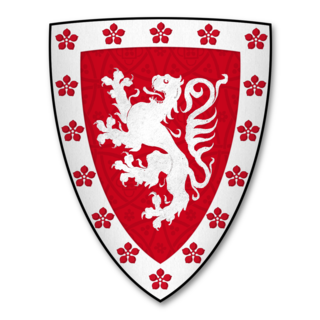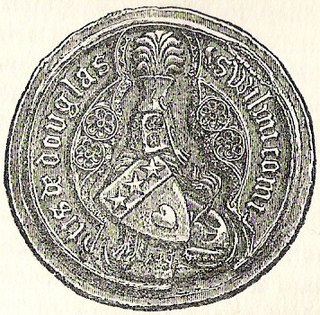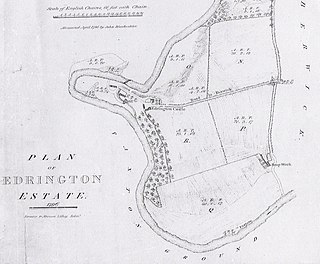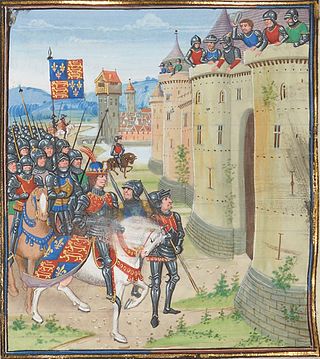Related Research Articles

The former Royal Burgh of Lauder is a town in the Scottish Borders in the historic county of Berwickshire. On the Southern Upland Way, the burgh lies 27 miles (43 km) southeast of Edinburgh, on the western edge of the Lammermuir Hills.
Andrew Moray, also known as Andrew de Moray, Andrew of Moray, or Andrew Murray, was an esquire, who became one of Scotland's war-leaders during the First Scottish War of Independence. Moray, son and heir to Sir Andrew Moray of Petty, an influential north Scotland baron, initially raised a small band of supporters at Avoch Castle in early summer 1297 to fight King Edward I of England, and soon had successfully regained control of the north for the absent Scots king, John Balliol. He subsequently merged his army with that of William Wallace, and jointly led the combined army to victory at the Battle of Stirling Bridge on 11 September 1297. Moray was mortally wounded in the fighting at Stirling, dying at an unknown date and place that year.

Sir James Douglas was a Scottish knight and feudal lord. He was one of the chief commanders during the Wars of Scottish Independence.

Patrick de Dunbar, 9th Earl of March, was a prominent Scottish magnate during the reigns of Robert the Bruce and David II.
Humphrey (VII) de Bohun, 4th Earl of Hereford was a member of a powerful Anglo-Norman family of the Welsh Marches and was one of the Ordainers who opposed Edward II's excesses.
Walter Stewart was the 6th Hereditary High Steward of Scotland and was the father of King Robert II of Scotland, the first Stewart monarch.
Sir Alexander Ramsay of Dalhousie was a Scottish nobleman and knight who fought for David II, King of Scots in the south of Scotland in the Second War of Scottish Independence. He achieved fame and prestige during the siege of Roxburgh Castle.

Berwick Castle is a ruined castle in Berwick-upon-Tweed, Northumberland, England.

William Douglas, 1st Earl of Douglas was a Scottish nobleman, peer, magnate, and head of the Black Douglas family. Under his leadership, the Black Douglases continued their climb to pre-eminence in Scottish politics begun under his uncle, Sir James the Good, as well as their military dominance of the south of Scotland.

Sir William Douglas "le Hardi", Lord of Douglas was a Scottish nobleman and soldier.

Edrington is a medieval estate occupying the lower part of Mordington parish in Berwickshire, Scottish Borders, Scotland, five miles (8.0 km) west of Berwick-upon-Tweed. From probably the 14th century, if not earlier, a castle occupied the steep hill above the mill of the same name on the Whiteadder Water. The castle ruin is still marked on today's Ordnance Survey maps, and still appears in locality references in The Berwickshire News. The principal farm of the estate is Edrington Mains.

Sir Robert de Lawedre (Lauder), Knt., of Quarrelwood, Edrington, and the Bass was Justiciar of Scotia, a Scottish soldier of great prominence and Captain of Urquhart Castle. He is recorded by Fordun, in his Scotichronicon, and in Extracta ex variis Cronicis Scocie as "Robertus de Lavedir 'the good'"
Sir Robert de Lawedre (Lauder) of Edrington & The Bass, Knt., was a Burgess of Edinburgh and a confidant of King Robert III and sometime Guardian of his son, the future James I of Scotland.
The Battle of Skaithmuir was a skirmish of the First War of Scottish Independence. It took place near Coldstream, on the Anglo-Scottish border, in February 1316. The skirmish was fought between the Scottish captain Sir James Douglas, and an English raiding party from Berwick upon Tweed. The English were having difficulty getting supplies to Berwick after the Scots had won back the surrounding territory and the garrison was facing starvation. Under Edmond Caillou, a Gascon knight, about 80 men set out from Berwick to raid Teviotdale for cattle. Douglas, having been informed that there were fewer in the raiding party, set out to cut them off. Douglas won, and Caillou was killed. Douglas later called it the most difficult fight of his long career. The Scots under Douglas and Thomas Randolph went on to capture Berwick in April 1318.

John Segrave, 2nd Baron Segrave was an English commander in the First War of Scottish Independence.
In July 1482 an English army invaded Scotland during the Anglo-Scottish Wars. The town of Berwick-upon-Tweed and its castle were captured and the English army briefly occupied Edinburgh. These events followed the signing of the Treaty of Fotheringhay, 11 June 1482, in which Alexander Stewart, Duke of Albany, the brother of James III of Scotland declared himself King of Scotland and swore loyalty to Edward IV of England. The follow-up invasion of Scotland under the command of Edward's brother, Richard, Duke of Gloucester failed to install Albany on the throne, but Berwick has remained English ever since the castle surrendered on 24 August. The English army left Edinburgh with a promise for the repayment of the dowry paid for the marriage of Princess Cecily of England to the Scottish Prince.
Sir Andrew Murray (1298–1338), also known as Sir Andrew Moray, or Sir Andrew de Moray, was a Scottish military and political leader who supported King David II of Scotland against Edward Balliol and King Edward III of England during the Second War of Scottish Independence. He held the lordships of Avoch and Petty in north Scotland, and Bothwell in west-central Scotland. In 1326 he married Christina Bruce, a sister of King Robert I of Scotland. Murray was twice chosen as Guardian of Scotland, first in 1332, and again from 1335 on his return to Scotland after his release from captivity in England. He held the guardianship until his death in 1338.
The Battle of Nesbit Moor was an engagement fought in August 1355 between forces of the Kingdom of Scotland and the Kingdom of England.
John Crabbe was a Flemish merchant, pirate and soldier who was active for around 35 years of his life. He defended Berwick Castle for the Scots against English forces in 1318, but after being captured by the English in 1332 assisted the English when they again besieged at Berwick in 1333, and became a loyal servant of Edward III, for whom he also fought at the Battle of Sluys.

The siege of Berwick lasted four months in 1333 and resulted in the Scottish-held town of Berwick-upon-Tweed being captured by an English army commanded by King Edward III. The year before, Edward Balliol had seized the Scottish Crown, surreptitiously supported by Edward III. He was shortly thereafter expelled from the kingdom by a popular uprising. Edward III used this as a casus belli and invaded Scotland. The immediate target was the strategically important border town of Berwick.
References
Notes
Sources
- Calendar of Documents relating to Scotland, ed. Bain, J. Vol III, AD 1307–1357. Edinburgh 1887.
- Balfour Paul, Sir James, Scots Peerage IX vols. Edinburgh 1904.
- Davis, I.M., The Black Douglas. London 1974.
- Barbour, J., The Brus ed.Mackenzie, W.M. London 1909.
- Fraser, Sir William, The Douglas Book IV vols. Edinburgh 1885.
- Haines, R.M, King Edward II: Edward of Caernarfon, his life, his reign, and its aftermath-1284-1330. McGill-Queens Univ. Press. 2003.
- Maxwell, Sir Herbert, History of the House of Douglas II vols. London 1902
- Michel, F.X.,Les Écossais en France, les Français en Écosse II vols. London 1862. (in French)
- Ross, D.R., James the Good-The Black Douglas. Glasgow 2008.